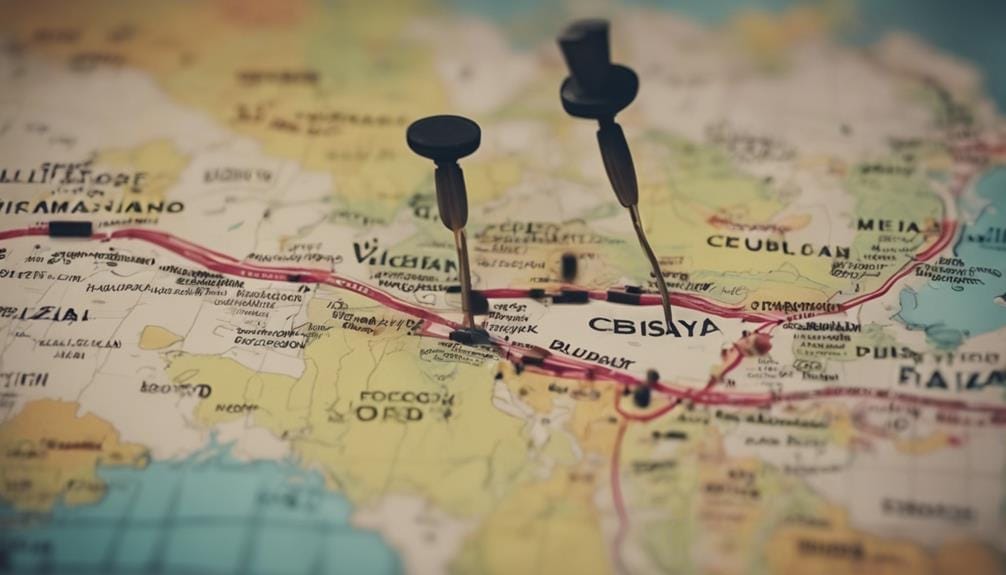Cebuano Vs Bisaya: Dialect Distinctions
When it comes to Cebuano vs Bisaya, the distinctions might surprise you. Understanding the nuances between these two terms can shed light on the complexities of language and identity in the Philippines.
From historical roots to modern-day usage, exploring the differences between Cebuano and Bisaya can provide valuable insights into the cultural tapestry of this diverse region.
Let’s uncover the layers that make these linguistic distinctions not just words but windows into a rich heritage waiting to be unraveled.
Key Takeaways
- Cebuano is primarily spoken in Cebu, while Bisaya encompasses a broader range of languages in the Visayan region.
- Cebuano has two language standards, Sugbuhanon and Sinugbuhanon, while Bisaya includes dialects like Hiligaynon and Waray.
- Spanish influence is prominent in Cebuano, whereas Bisaya exhibits unique phonological characteristics.
- Understanding these linguistic differences is crucial for appreciating the cultural diversity and nuances of the Visayan region.
Origins and History
The origins and history of Cebuano and Bisaya languages within the Visayan group are deeply intertwined with the rich linguistic heritage of the Philippines. These languages belong to the Central Philippine languages, a subgroup of the Austronesian language family. The Visayan languages, including Cebuano and Bisaya, have evolved over centuries, shaped by interactions with various cultures and historical events.
The term ‘Bisaya’ is often used synonymously with Cebuano, but it encompasses a broader range of languages spoken by the Visayan people. Cebuano, specifically associated with the Cebu province, holds a significant position within the Visayan language spectrum. The roots of these languages trace back to the Austronesian language family, reflecting the indigenous linguistic landscape of the region.
Moreover, the history of Cebuano and Bisaya languages bears the imprint of Spanish colonial influence. The Spanish era introduced lexical and phonological changes, amalgamating Hispanic elements with the native linguistic substratum. This historical amalgamation has endowed Cebuano and Bisaya with a distinct linguistic character, blending indigenous roots with external influences.
Linguistic Differences

In exploring the linguistic differences between Cebuano and Bisaya, one can discern distinct variations in language standards and phonological characteristics that reflect the diverse linguistic landscape of the Visayan region.
Cebuano, as a specific language standard within the Visayan languages, is primarily spoken in the Cebu province. On the other hand, Bisaya serves as a collective term encompassing a broader group of languages spoken across different parts of the Visayan region.
Cebuano has two language standards, Sugbuhanon and Sinugbuhanon, while Bisaya includes languages like Hiligaynon and Waray. Cebuano exhibits influences from Spanish rule, leading to similarities with the Spanish language, whereas Bisaya languages present unique phonological characteristics and variations in sound changes.
Recognizing the distinction between Cebuano and Bisaya is crucial for understanding the specific language and cultural nuances within the central Visayan linguistic landscape.
Geographical Distribution

Geographical distribution plays a significant role in shaping the linguistic landscape of the Visayan region, delineating the prevalence and variation of Cebuano and Bisaya dialects across different islands and communities.
- Distinct Languages: Cebuano is primarily spoken in the Cebu province, while Bisaya refers to people in the Visayan region comprising different islands.
- Regional Dialects: Bisaya encompasses various regional dialects such as Cebuano, Boholano, Leyteño, Mindanao Bisaya, and Surigaonon.
- Varied Distribution: The distribution of Cebuano and Bisaya speakers varies across the Visayan islands and regions, influencing the linguistic landscape.
- Urban vs. Rural: Cebuano is more prevalent in urban areas like Cebu City, while Bisaya dialects are commonly spoken in rural and coastal communities.
Understanding the geographical distribution of these languages provides insight into the cultural diversity and language variations within the Visayan region. The interplay between ethnic groups and the languages spoken in specific areas contributes to the rich tapestry of the Visayas region.
Cultural Significance

With significant cultural implications, Cebuano and Bisaya languages hold paramount importance in the Visayan region of the Philippines. Cebuano, being one of the languages spoken in the Philippines, is part of the Central Philippine language family and serves as a lingua franca for many Visayan people.
Bisaya, on the other hand, encompasses a group of related languages within the Visayan language family. Both languages not only reflect the rich history and traditions of the Visayan people but also play a crucial role in preserving the cultural heritage of the region.
Understanding the cultural significance of Cebuano and Bisaya can provide insights into the diverse heritage of the Philippines. It can deepen one’s appreciation for the customs, beliefs, and values that are embedded in these languages.
Moreover, knowledge of these languages can facilitate better communication and foster stronger relationships within Visayan communities, contributing to the preservation and promotion of the unique cultural identity of the Visayan people.
What is the significance of the Cebuano and Bisaya dialect distinctions in the context of luxury hotels in Cebu?
The significance of the Cebuano and Bisaya dialect distinctions in the context of unparalleled luxury hotels in Cebu lies in creating a personalized and culturally immersive experience for guests. By understanding and respecting the nuances of the local language, hotels can better cater to the needs and preferences of their Cebuano and Bisaya-speaking guests.
Learning Resources

Exploring various learning resources is crucial for enhancing your proficiency in Cebuano or Bisaya languages. To delve deeper into these Southern Philippine languages, consider the following:
- Online Platforms: Utilize tools like Duolingo and Rosetta Stone to immerse yourself in Cebuano or Bisaya.
- Language Exchange: Join online communities or programs to practice with native speakers and enhance your conversational skills.
- Media Immersion: Watch movies, TV shows, and YouTube channels in Cebuano or Bisaya to absorb the language and culture.
- Language Apps: Access vocabulary and phrases conveniently with apps like ‘Bisaya Buddy’ or ‘Cebuano Phrasebook’.
Experience more of Cebuano accommodation at Southpole Central Hotel, where comfort, convenience, and affordability converge in the heart of Cebu City. Immerse yourself in the local hospitality and vibrant atmosphere during your stay with us.
Conclusion
In conclusion, the distinctions between Cebuano and Bisaya are rooted in their historical origins, linguistic variations, geographical distribution, and cultural significance within the Visayan region.
While both languages share a common Austronesian classification, their unique characteristics make them integral components of the diverse linguistic landscape of the Philippines.
Understanding the nuances between Cebuano and Bisaya enriches our appreciation of the rich heritage and cultural heritage of the Visayan people.
Frequently Asked Questions
What Is the Difference Between Cebuano and Visayan?
Cebuano and Visayan encompass cultural and linguistic differences. Cebuano focuses on the language in Cebu, influenced by Spanish. Visayan is a broader term for the region, comprising various ethnic groups and languages. Both share historical roots but exhibit dialect variations and regional influences.
What Language Is Closest to Cebuano?
The Cebuano language is closely related to other Visayan languages like Hiligaynon and Waray-Waray, sharing language similarities and regional differences. Dialect variations, cultural influences, pronunciation nuances, and historical connections enrich its linguistic tapestry.
How Different Are Cebuano and Tagalog?
Cebuano and Tagalog differ significantly in language variations and cultural influences. Dialectal differences and regional identities shape these languages. Despite some linguistic evolution, mutual intelligibility remains limited due to distinct phonetic systems, sentence structures, and word orders.
Do They Speak Tagalog in Cebu?
Yes, Tagalog has some influence in Cebu due to historical ties, but Cebuanos primarily speak Cebuano. Dialect variations within Cebu reflect the rich language diversity. While Tagalog may be understood, Cebuano remains the dominant language.







